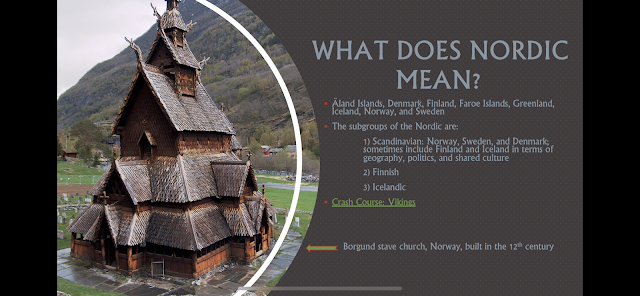Today's focus is on Iceland, Finland, and Denmark. Simply because of my personal interests and not for any serious academic reason.
Icelandic literature is unique in that the language never evolved in ways the languages of mainland Europe did. They were an insular society that was not subjected to cultural clashes that come from other conquering, not Norse speaking, people. Today's Icelandic language is close enough to Old Norse that there aren't many difficulties in reading and understanding it. Unlike the English language where we see Old English and it's literally a foreign language.
The Codex Regius is the Icelandic codex where many Old Norse poems have been preserved. The title, when translated from the Latin, is "King's Book." It contains the Poetic Edda, which is considered to be an Icelandic national treasure. The Codex dates to 1270.
The Prose Edda (Younger Edda) was written by Snori Sturluson (fantastic name, by the way) c. 1220. It was written as a text book of sorts, and contains the most complete and detailed source of Norse Mythology. The Poetic Edda is a poetic saga. Within the poem, is the "Voluspa" which details the history of the Norse gods, men, and creatures from the beginning to their eternal end.
Both Edda manuscripts tell the stories of the Norse gods and myths, focusing on Odin, Baldr, Thor, and Valhalla.
JRR Tolkien was enamored of Norse literature. From a section of the "Voluspa" that is about the dwarves, Tolkien use several of the dwarf names listed in his works: Durin, Dualin, Dain, Bifur, Bofur, Bombus, Nori, Dori, Ori, Thrain, Thorin, Fili, Kili, Gloin, and from another section the name Gandalf.
Tolkien also wrote many translations of Norse texts: The Legend of Sigurd and Gudrun. He also did a translation of Beowulf for those interested in reading that from the Anglo-Saxon period of British Literature.
Chronological order simply means that a saga begins at its natural beginning-- birth-- and then ends the way all things do-- death.
While the saga contains a good chunk of history, we can't take it as absolute history because the mythology is weaved into the text of the historical narrative. What we do get is a better understanding of every day life among the Icelandic/Nordic peoples.
These stories were of pagan origin, and as Christianity made its way north into the Nordic lands (c. 870-930 CE), Christian principles were added in or given updated "Christian" endings, the literary way of the pagan stories to continue and then step aside for Christianity.
Norse Mythology is not just what we've seen in the Marvel Comic Universe, and even then, it has changed far and beyond the stories of the Old Norse poems and sagas.
Neil Gaiman tells us why Norse Mythology is important to read and conveniently, he has also written his own take on the mythology.
Here is Crash Course: Norse Mythology to break down the Pantheon.
Ratatoskr is the messenger to the Norse gods. He's also a squirrel. Because that's good story.
Fenrir is the wolf god in Norse mythology. For those of you who have read Harry Potter know that the dark werewolf is named Fenrir Greyback.
- Väinämöinen (good luck pronouncing that) is the main character who plays a kantele (or zither). Here is what the kantele sounds like: Nuku Nuku- Ancient Finnish Lullaby.
- Kullervo, another character, sees his uncle killing his father. Shakespeare was inspired by this and used it in Hamlet.
- Jean Sebelius (1865-1957) was a Finnish composer and much of his music was inspired by Kalevala.
- Tolkien built Middle Earth, and Finnish Grammar inspired his creation of the language Quenya. For the nerd types, the Appendices from the extended edition of Return of the King, goes into detail about Tolkien's love of the Norse sagas, the language and grammar, and Kalevala.
The Danmarks gamle Folkeviser is a collection of all known texts and recordings of old Danish ballads. There are some 539 ballads in the collection.
Folklore and Fairytales had a link to what fairytales are as a literary construct. I decided to hold this link to a later class when we have more fairytale stories to discuss.
Hans Christian Andersen is the ultimate in modern Danish literature. From Copenhagen, he wrote abundantly and rarely threw anything out. He left a large cache of letters and diaries.
The movie Hans Christian Andersen is a 1952 musical starring Danny Kaye. This clip is the story The King's New Clothes.
The Faroe Islands fascinate me-- they are on my bucket list-- and their literary/cultural history is exceptionally unique.
Roam the Faroe Islands










No comments:
Post a Comment